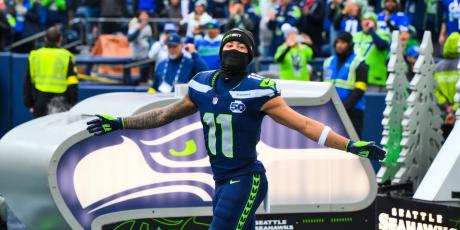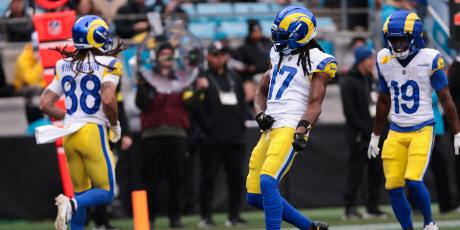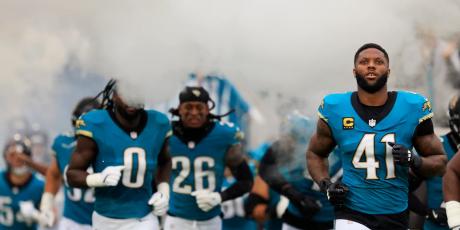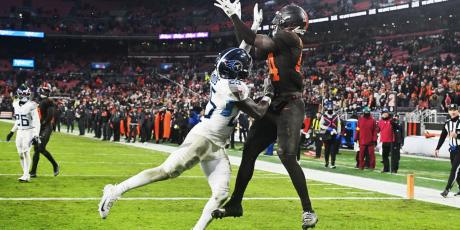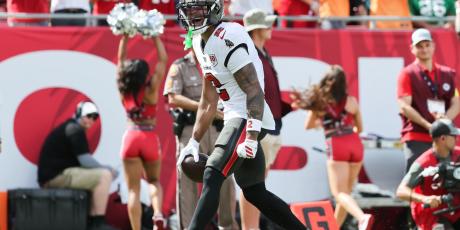Streaming Defenses Works and Here's How to Do It

Have you ever made a hasty decision in fantasy football that you later regretted? Imagine sitting in a draft last summer and feeling great about your team. You’ve selected an array of running backs and wide receivers that were on your must draft list. You also selected a top-tier tight end and landed one of the top projected quarterbacks. Visions of grandeur enter your mind about how you are going to dominate the competition in your fantasy league. You’re now on the clock in the eighth round, deviate from your strategy, and decide to draft the Chicago Bears defense. You think to yourself “This is the number one ranked defense in fantasy. What could possibly go wrong?!” You didn’t know it then, but your hubris just became your own worst enemy.
The Bears were the first DST selected in fantasy drafts according to Fantasy Football Calculator last summer in 12-team single quarterback and half-point PPR formats. Chicago finished the 2018 season as the top DST with 187 fantasy points. The Bears defense allowed the third-fewest yards per game (299.7), led the NFL in interceptions (27), and led the league with sixth defensive touchdowns. Once the dust settled on the 2019 season the Bears DST finished 17th.
Opportunity cost risks in fantasy football should not be overlooked. It occurs when a better opportunity presents itself after an irreversible decision has been made. It can guide you to more profitable decision-making in a live draft. You must assess the relative risk of each option in addition to its potential returns.
There are a number of fantasy difference-makers who could have been on your team if you waited to acquire a defense. Lamar Jackson, Russell Wilson, Dak Prescott, and Josh Allen were readily available at the quarterback position when the Bears were going off the board. Courtland Sutton, John Brown, and D.K. Metcalf were some of the wide receivers available. Mark Andrews and Austin Hooper were tight ends that were available.
That last paragraph may have made you nauseous if you drafted a highly ranked defense early and missed out on some of the players mentioned. Streaming is the smart play and one of the best strategies in fantasy football. This article will highlight why streaming works and the essential components you should know about that go into predicting defensive scoring.
Why Streaming Defenses Works
Streaming defenses, at its core, isn’t an elaborate strategy. The first step is to target a defense in your fantasy draft that begins the season with favorable matchups against subpar offenses from the previous year. The second step would be to acquire the best option from the waiver wire week to week and swap that DST out for another one. You’ll replicate this process all season rather than using one of your coveted draft picks trying to acquire a top defense.
The NFL has tipped everything in favor of offenses. Total yards and points scored have trended up. I’m sure we can both agree that defenses are at a disadvantage. You see my point, right? It’s important to leverage every potential edge you have in order to win your fantasy football league. Streaming defenses is a winning strategy. It gives the ability to load your roster with high-upside or consistent players at various positions. Are you still not sold on streaming? Let me lift the veil and break it down for you.
This study of 2019 ADP paints a clear picture of why spending an early pick on a DST is a miscalculation.
| Rank | Team | ADP | Fantasy Points | Fantasy Points Per Game |
|---|---|---|---|---|
| 1 | NE | 146.2 | 224 | 14.0 |
| 2 | PIT | 166.3 | 180 | 11.2 |
| 3 | SF | 187.0 | 163 | 10.2 |
| 4 | BAL | 114.9 | 150 | 9.4 |
| 5 | LAR | 105.4 | 146 | 9.1 |
| 6 | KC | 163.1 | 144 | 9.0 |
| 7 | MIN | 122.4 | 143 | 8.9 |
| 8 | NO | 170.6 | 141 | 8.8 |
| 9 | TB | 185.0 | 137 | 8.6 |
| 10 | NYJ | 166.9 | 132 | 8.2 |
| 11 | BUF | 171.8 | 130 | 8.1 |
| 12 | TEN | 179.0 | 125 | 7.8 |
| 13 | IND | 167.1 | 124 | 7.8 |
| 14 | SEA | 162.5 | 118 | 7.4 |
| 15 | PHI | 162.7 | 109 | 6.8 |
| 16 | GB | 166.3 | 108 | 6.8 |
| 17 | CHI | 88.9 | 105 | 6.6 |
| 18 | JAX | 109.8 | 99 | 6.2 |
| 19 | DAL | 140.3 | 99 | 6.2 |
| 20 | DEN | 145.1 | 99 | 6.2 |
| 21 | ATL | 174 | 94 | 5.9 |
| 22 | WAS | 183.0 | 92 | 5.8 |
| 23 | CAR | 189.0 | 91 | 5.7 |
| 24 | HOU | 167.4 | 90 | 5.6 |
| 25 | CLE | 127.5 | 87 | 5.4 |
| 26 | LAC | 131.1 | 82 | 5.1 |
| 27 | NYG | 177.0 | 82 | 5.1 |
| 28 | DET | 181.0 | 80 | 5.0 |
| 29 | LV | 182.0 | 70 | 4.4 |
| 30 | ARI | 165.0 | 67 | 4.2 |
| 31 | CIN | 186.0 | 67 | 4.2 |
| 32 | MIA | 176.0 | 53 | 3.3 |
The Patriots DST finished as the top fantasy defense in 2019 and was readily available in the later rounds of drafts last summer. The Steelers, 49ers, Chiefs, Vikings, and Saints went mainly undrafted and finished in the top-10. The Rams were another defense that was selected in the single-digit rounds of many drafts heading into last season. It’s ironic that the Buccaneers defense could have been your last pick and scored just as many points as Los Angeles. What other observations do you have after looking at the chart above?
So far, many are buying into the 49ers, Steelers, and Ravens defenses early in 2020 drafts. All three of these teams are being selected eighth and ninth rounds of 12-team formats. You must be wondering how to identify a viable defense to stream. We will go into the details of how to predict great matchups below, but one place to start is our Hot Spot tool for team defense. This resource will update during the season to reflect the performance of each team. After a few weeks, the bright green squares should start to pinpoint some of the opponents we want to target.
What We Look For
Target Struggling Offenses
I can almost hear you thinking that this advice is as surface level as it gets, but it’s true. The Cowboys (431.5), Ravens (414.8), Buccaneers (398.0), and Chiefs (384.3) were the top four ranked offenses in total yards per game in 2019. All four of these offenses are well-positioned to replicate this feat in 2020. My goal is to turn you into a fantasy shark. Did you know that sharks can smell blood from up to around a quarter of a mile away? Let’s discuss what you should look for when targeting potential streamers.
Last season, Washington, Cincinnati, Miami, and New York were offenses you could bully last season and expect a top-10 finish from your defense. Substandard offenses tend to have substandard quarterback play, inferior offensive line play, and hardly any offensive playmakers. These elements put together results in a low number of points allowed and a bonanza of sacks, turnovers, touchdowns for the defense. Here are some statistics that provide clear evidence of how or bad an offense is:
Total Yards and Point Scored Per Game
The total yards and points scored per game are useful to identify bad offenses. The Jets (273), Washington (275), Steelers (277), and Bears (297) were the bottom-four offenses in total yards per game last season. Washington (16.6), Jets (17.2), Bengals (17.4), and the Bears (17.5) were the bottom-four offenses in points scored per game. It’s important to take into account what changes certain teams have made from one season to the next. Has the team’s coaching staff changed? How did free agency and the NFL Draft affect the roster? The Dolphins, Jets, and Washington offenses don’t look good on paper. The Texans offense is built on a house of cards with Brandin Cooks, Will Fuller, and David Johnson. A few injuries could derail Houston’s offense.
Turnover Differential
Turnover differential is another statistic you should become familiar with. It is calculated by subtracting the total number of giveaways (interceptions and fumbles lost) from the total number of takeaways (interceptions and opponent fumble recoveries). Targeting offense with negative turnover differentials provides a DST a high ceiling because defensive touchdowns can occur on turnovers. The Panthers (-14), Bengals (-14), Chargers (-17), and Giants (-17)were the bottom-four offenses in turnover differential in 2019. The only other offenses with a double-digit negative turnover differential were the Buccaneers (-13) and Dolphins (-10).
Passing Yards Per Game, Interceptions Per Game, and Sacks Per Dropback
Were you aware that offensive line play has the greatest impact on the success of an NFL offense? It impacts the passing and running game. You want to target offenses with inexperienced or inefficient quarterbacks who are more susceptible to sacks or turnovers than the league average. Accuracy, arm strength, mental toughness, pocket presence, and situational awareness are a few traits that help define a great quarterback from a film perspective. From a statistical perspective, you can look at a quarterback’s passing yards and interceptions per game. Sacks are also important, but aren’t very predictive. There is variance from one season to the next. One stat that is overlooked and can be useful in predicting sacks than sacks themselves in subsequent seasons is Pressure Rate.
Pressure Rate
You may be wondering why pressure is so important when it comes to streaming defenses. It can disrupt an entire offense. Getting pressure from defenders on the edge is the typical form of generating sacks and hurries. Quarterbacks like Tom Brady, Drew Brees and Aaron Rogers are masters at manipulating the pocket.
Interior pressure is more valuable than edge pressure because it’s more difficult for the quarterback to get out trouble. Pressures can disrupt an entire offense and turn into sacks, which lead to fantasy points for defenses. Football Outsiders has a metric called Rate of Adjusted Pressure (RAP), which measures a team’s ability to generate or avoid pressure. These offenses had the highest allowed pressure rates in 2019:
| Rank | Offense | Pressure Rate | RAP | Difference |
|---|---|---|---|---|
| 32 | NYJ | 34.1% | 34.3% | -0.20% |
| 31 | MIA | 31.1% | 32.5% | -1.40% |
| 30 | SEA | 31.8% | 32.3% | -0.50% |
| 29 | HOU | 29.6% | 30.9% | -1.30% |
| 28 | IND | 30.0% | 29.8% | 0.20% |
| 27 | DEN | 27.7% | 28.6% | -0.90% |
| 26 | NYG | 28.3% | 28.2% | 0.20% |
| 25 | KC | 27.8% | 28.2% | -0.40% |
| 24 | LAR | 27.0% | 27.5% | -0.50% |
| 23 | BUF | 27.6% | 27.4% | 0.20% |
The Jets, Bengals, Chargers and Washington’s offensive lines enter the 2020 season with question marks now that the dust has settled on free agency and the NFL Draft.
It’s also useful to look at a quarterback’s true passer rating. This rating factors out unpressured throwaways and dropped passes. It’s also useful to examine a quarterback’s passer rating from a clean pocket compared to when he’s under pressure.
Pay Attention to the NFL Injury Reports
You’ll want to monitor the NFL Injury Reports during the week. Quarterbacks are the engines that propel most offenses. If a starter is trending toward being ruled out then the defense they are facing should move to the top of your streaming list. Not all backup quarterbacks in the NFL are created equal. If a team has lost one of its key offensive players then that defense should also be on your radar. Imagine if the Bears were going to be without Allen Robinson. How about Washington without Terry McLaurin. Injuries to key defensive players is also something that you be mindful of. A unit without its top pass rusher or cornerback is a suboptimal defense to stream.
Pay Attention to the Vegas Lines
Does the thought of using Vegas odds in your fantasy football preparation make you shudder? You’re not alone, but you’ll have a healthy advantage over your competition by reviewing the numbers predicted by oddsmakers. It’s a good best practice to pay close attention to Vegas lines. They use fine-tuned computer models that provide insight into which defenses to stream. The goal is to target defenses facing opponents with low implied team totals. You can find this by subtracting the spread from the over/over and dividing by two. The implied team total tells us the number of points that Vegas predicts them to score.
Schedule Adjusted-Fantasy Points Allowed (aFPA)
Our aFPA tool is an excellent resource to assist in your search for defenses to stream. Our signature strength of schedule metric removes any biases to provide you with a more accurate picture as you compare matchups. This metric is a simple way to gain an immediate glimpse at which defenses have a particularly easy or difficult schedule. It’s a good best practice to sort from strongest to weakest in order to identify which defenses to target. The Cardinals, Bills, Dolphins, Chargers, and Seahawks defenses have the easiest schedules according to aFPA.
Bringing It All Together
You now understand why streaming defenses works and how to do it. Here’s what comes next. We will dive deeper into aFPA and also identify a couple of defenses you can pair together at the end of your draft. What was your favorite takeaway? Hit me up on Twitter and tell me about it. Until next time!







